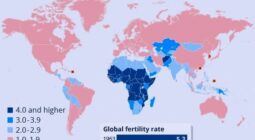Child marriages are surging in Asia and other developing countries. In Asia, child marriage occurs more frequently among girls who are the least educated, poorest and living in rural areas.
Child marriage is defined by the United Nations and other international organizations as any formal marriage or informal union between a child under the age of 18 and an adult or another child.
Marriages of this type mostly involve underage girls. About 750 million women under 18 get married, with 30% of them being less than 15 years old, according to the United Nations Children’s Fund (UNICEF).
The marriages will not only deprive children of educational opportunities but early pregnancy and childbearing come with a higher risk of death. Marrying too young can also contribute to poverty and domestic violence.
The United Nations defines child marriage as a human rights violation: girls who marry at a young age are less likely to remain in school and more likely to experience domestic violence. Child brides often become pregnant during adolescence, which comes with a higher risk of dangerous complications.
As of 2020, one in five young women globally was married before their 18th birthday – six times higher than the proportion of child marriage among boys. In many cases, they have no say in the issue being forced into marriage by their families.
These concerns have raised the possibility that the international community may miss its goal of ending the practice by 2030 as pandemic-related causalities surge.
By region, South Asia reported the most child marriages. The unions are also common in West and Central Africa, South America and the Caribbean region where COVID-19 vaccinations have been slow.
However, several countries have proposed or passed laws in recent years to try to curb the harmful practice but local traditions are hard to change.
In Nepal, child marriage has been illegal since 1963 setting at 20 years old for both men and women eligible for marriage.
Nepal has one of the highest rates of child marriage in Asia for both girls and boys and also has one of the highest legal ages of marriage in the world.
Although the legal age of unions for both sexes is 20, more than a third of young women aged 20-24 report that they were married by the age of 18, and just over one in ten by 15.
Nepali boys are among the most likely in the world to be child grooms. More than one in ten is married before they reach 18. Just over one in eight Nepali women had babies before the age of 18, which puts them at a higher risk of death or injury during childbirth.
In Nepal, 41 percent of women aged 20 to 24 are married before they turn 18. The country has the third highest child marriage prevalence in South Asia.
Thirty-seven percent of girls in Nepal marry before age 18 and 10 percent are married by age 15, in spite of the fact that the minimum age of marriage under Nepali law is 20 years of age.
Boys also often marry young in Nepal, though in lower numbers than girls. UNICEF data indicates that Nepal has the third highest rate of child marriage in Asia, after Bangladesh and India.
India has proposed legislation to raise the minimum marriage age for women from 18 to 21 years old, the same as men has resulted in parents rushing to marry off their teenage daughters.
Indonesia, which has one of the highest number of child brides in the world, raised the minimum age for women to marry to 19. It was 16 earlier.
In the Philippines, where one in six girls enters wedlock before the age of 18, now child marriage became illegal awarding prison terms of up to 12 years.
UNICEF estimated that 10 million additional child marriages may occur before 2030, with school closures forecast to increase child marriages by 25% and mercenary marriages involving grooms from poor families with many children could increase 3%. The fund has projected that 100 million underage children would get married by 2030.
Save the Children estimates that there were about 500,000 child marriages worldwide amid the pandemic in 2020. The group says about 2.5 million additional children have to marry by 2025 due to the pandemic and its subsequent economic slowdowns and impoverishment.
Besides many other social factors poverty, the low value attached to daughters, and lack of access to education, child labor, social pressures and harmful practices, gender inequality and damaging social norms make girls less valued than boys in society, caste system and patriarchal culture are contributory factors. However, political unrest may also cause child marriages to increase.
Thus, many of the marriages were arranged and, often, forced by girls’ parents, or other family members. Also, families forced girls to marry at under-age, making them drop out of school. Married girls had babies early, sometimes because they did not have information about and access to contraception, and sometimes because their in-laws and husbands pressured them to give birth as soon, and as frequently, as possible.
In Nepal, ending child marriage is a target under Sustainable Development Goals 5.3 and 16.2 and in 2016, the Nepal Government endorsed a National Strategy to End Child Marriage in Nepal by 2030.
UNICEF describes child marriage is a human rights violation, restricting children’s choices, changing their course in life, and putting them at significant risk of abuse and violence. One in three married girls in Nepal had been subjected to sexual violence by their husbands, while one in six reported physical violence, UNICEF study finds.
It increasingly appears that teenagers are choosing their own partners and may even elope. In some cases, parents encourage adolescents to initiate their own marriage to avoid the high costs associated with dowry or wedding.
Adolescents may also choose to elope as sexual expression outside of marriage is not acceptable, to avoid forced or arranged marriage or to escape from difficulties at home.
Anyway there are many positive steps undergoing even though much works need yet to be done. An action plan to implement the strategy is due and investment along with broader partnerships are required to bring about the necessary changes to end the practice in Nepal.
(The writer is a medical staff with having international experiences)









